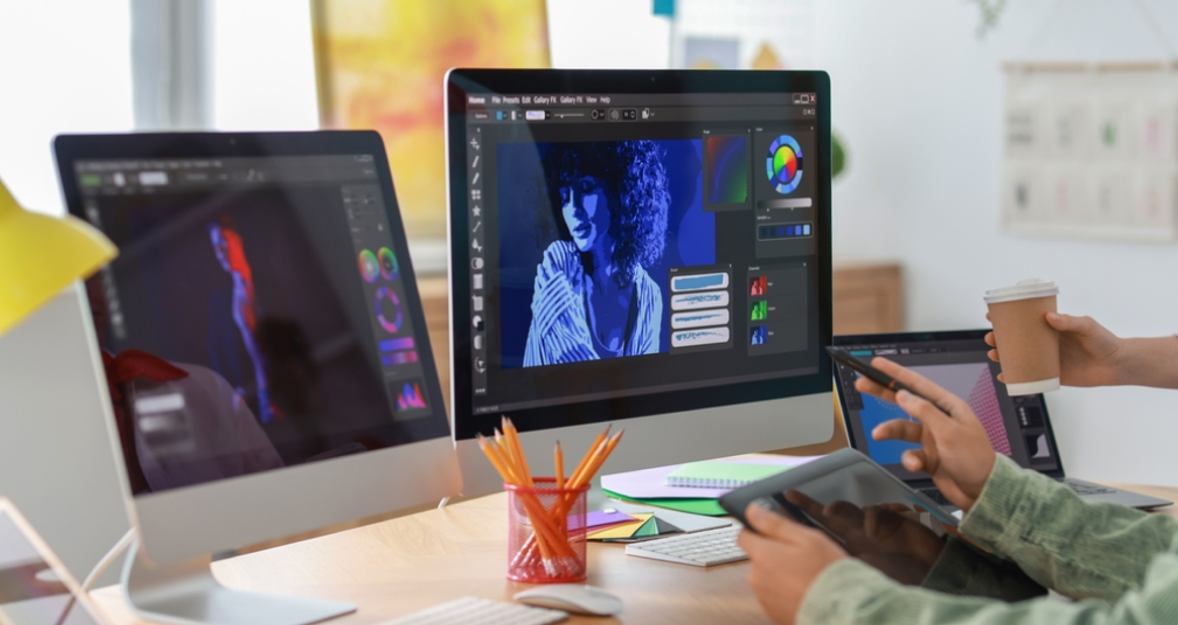August 20
13 min. to read
How To Use AI To Edit Photos And Skip Hours Of Work
Photo editing used to eat up time. You’d retouch, mask, sharpen, fix skin, and tweak colors—an hour here, two hours there. Today, smart tools handle much of the heavy lifting.
This guide gives clear, practical steps to edit faster, keep control, and get consistent, professional images (with no fluff). You’ll get concrete, repeatable steps you can use from import to export. We’ll show which AI tricks actually save time and which ones need a careful hand. By the end, you’ll have a lean, reliable workflow that keeps your creative voice intact.
Why AI Helps (And What It Won’t Replace)
 AI speeds repetitive tasks: removing sensor noise, sharpening fine detail, separating subject from background, and suggesting color fixes. It won’t replace taste, creativity, or a human eye that knows the client. Think of artificial intelligence as a skilled assistant: fast, reliable on routine jobs, and happiest when you give clear direction.
AI speeds repetitive tasks: removing sensor noise, sharpening fine detail, separating subject from background, and suggesting color fixes. It won’t replace taste, creativity, or a human eye that knows the client. Think of artificial intelligence as a skilled assistant: fast, reliable on routine jobs, and happiest when you give clear direction.
AI excels at: bulk fixes, sharpening, initial skin retouch, and background separation. BUT you still need to things like choosing final crops, tweaking mood, and validating skin tones.
Once you learn to edit photos with artificial intelligence, you’ll see it’s less about replacing skill and more about speeding up the parts you already know how to do well.
Exclusive Tools of Endless Possibilities in One AI Editor
Explore Now!First 10 Minutes: Set Up A Workflow That Saves Hours Later
 Before you edit a single photo, pick an app and set folder rules. A solid workflow reduces rework.
Before you edit a single photo, pick an app and set folder rules. A solid workflow reduces rework.
Create folders: RAW / To Edit / Exports.
Batch-rename imports (date_subject).
Decide on the presets you use for 70% of images, and smart editing tools will speed the rest.
Once you understand how to edit photo using AI, you can break big jobs into quick, repeatable steps without losing creative control.
Fast Edit For A Single Portrait: Step-by-Step
 Use this when you have 10–200 photos and need consistent results.
Use this when you have 10–200 photos and need consistent results.
Import all RAW files into your editor.
Run automatic exposure & white balance.
Apply a gentle global smart editing correction (auto-tone).
Run a targeted AI masking on the subject to isolate adjustments. This saves tons of brushing time.
Use an AI face editor for fast but natural skin smoothing and eye sharpening.
Apply a final pass with an AI sharpener for micro-detail recovery.
Export with standardized naming and size presets.
Between steps, inspect at 100% for artifacts and refine mask edges only when needed.
Bold Shortcut: Three Go-To AI Fixes
 When time is tight, these three focused fixes give the biggest visual return for minimal effort.
When time is tight, these three focused fixes give the biggest visual return for minimal effort.
Remove noise and apply global light fixes.
Auto-mask subject, then dodge/burn locally.
Targeted face edits: eyes, teeth, skin—subtle.
Apply each fix lightly, check at 100%, and tweak the strength to match the image so the results stay natural.
Manual vs AI Time: Conservative Table For A 50-Photo Shoot
Numbers speak louder than hype, right? This table shows realistic time savings for common edits.
Task | Manual Time per Photo | AI-Assisted per Photo | Time Saved (Total for 50) |
Masking subject | 6–10 min | 30–60 sec | ~4–8 hours |
Skin retouch | 8–12 min | 45–90 sec | ~6–8 hours |
Sharpening & final | 3–5 min | 15–30 sec | ~2–4 hours |
Total | 17–27 min | 1.5–3 min | ~12–20 hours saved |
This is conservative—for tougher edits, savings are larger. Want to try a streamlined workflow? Start with Luminar Neo, AI-powered photo editing software, and see how much time you save on your next batch.
How To Preserve Your Creative Voice When AI Suggests Fixes
 Artificial intelligence often makes safe, neutral choices. Use that as a starting point:
Artificial intelligence often makes safe, neutral choices. Use that as a starting point:
Treat automated editing as the first pass.
Adjust contrast, color grading, and local light to match your style.
Keep a small set of signature presets; use AI to get images to a mid-point quickly, then apply your signature look.
Always keep one reference image that represents your desired style and compare during edits.
Practical Settings And Tips That Save Time
 These quick, practical settings shave minutes off every file while keeping image quality intact.
These quick, practical settings shave minutes off every file while keeping image quality intact.
Use batch-to-all: apply global settings, then tweak per image.
Always check masks at 100% for hair and fur.
Reduce aggressive smoothing: set skin sliders low to preserve pores.
For high-ISO images, denoise before sharpening.
Keep shadow recovery moderate to avoid gritty midtones.
Turn ideas into polished edits fast—try the AI Prompt Photo Editor. It helps you bring creative visions to life in just a few clicks, without spending hours on manual adjustments.
Prompts And Automation: How To Instruct AI Clearly
 When using AI to edit photos that accept text prompts or when using ChatGPT as a helper, clarity matters.
When using AI to edit photos that accept text prompts or when using ChatGPT as a helper, clarity matters.
Bad prompt: “Make it better.”
Good prompt: “Bring subject forward: +15% exposure, warm highlights, preserve skin texture, increase eye clarity by 20%.”
If you want ready-made ideas, check curated ChatGPT prompts for photo editing you can paste into editors or prompt-driven tools.
A Short Checklist Before Exporting
Before you hit export, run this short checklist to catch last-minute issues.
Check skin tones on multiple monitors.
Inspect sharpness at 100% on a critical image.
Export settings: sRGB for web, ProPhoto or Adobe RGB for print.
Use meaningful file names (client_date_sequence).
If anything fails this checklist, fix it now—exporting and sending the wrong version costs more time than a quick re-check.
When To Avoid Full Automation
Automation is powerful, but there are clear cases where it does more harm than good—watch for these.
Complex composites that need creative masking.
Delicate editorial color grading where historical accuracy matters.
Shots with mixed lighting and reflective surfaces.
If the scene needs subtle, handcrafted decisions, use AI only for roughing in—then finish manually.
Practical Case: Wedding Photographer Workflow
 A wedding shooter with 800 images can use AI to triage and process:
A wedding shooter with 800 images can use AI to triage and process:
Cull with smart markers (auto-flagging of sharp/closed-eye shots).
Batch auto-fix exposure + white balance.
Auto-mask key portraits and run face edits.
Manually refine the top 100 images for the album.
This cuts selection + rough editing time from days to a few focused hours and keeps the creative choices where they belong. For portraits, AI assisted photo editing can take care of base skin smoothing and exposure balancing, leaving you free to fine-tune color and mood.
Quick Sample Prompts You Can Paste
“Enhance subject separation, warm highlights, natural skin texture.”
“Reduce noise, retain fine detail, sharpen eyes only.”
“Create a moody teal-and-orange grade, keep skin neutral.”
Use these as a baseline—tweak numbers for taste. For a broader comparison of tools, see this roundup on the best AI photo editor to match features to your needs.
Your AI-Powered Photo Editor for MacOS and Windows
Discover Now!Good Habits For Predictable Quality
Adopt a few simple habits to keep results consistent and avoid repeat work.
Keep a “top 10” preset library.
Save user-made masks for recurring problem types.
Update software monthly—AI models iterate fast.
Keep a versioned file system so you can revert changes.
Troubleshooting—Fixes For Common AI Hiccups
When AI stumbles on fine details, these quick fixes will usually rescue the shot without much fuss.
If the mask cuts hair: increase mask feather and smooth edges.
If skin looks plastic: reduce smoothing strength and reintroduce grain.
If eyes over-sharpen: apply sharpening only on a masked layer that excludes iris edges.
Ethical And Backup Considerations
 AI can make drastic edits quickly. Keep client approval in the loop for major changes (especially skin/identity edits). Always archive RAW files and versioned edits so you can revert or re-edit later. Get written consent for substantial retouches—send before/after proofs and save the client’s approval with each job.
AI can make drastic edits quickly. Keep client approval in the loop for major changes (especially skin/identity edits). Always archive RAW files and versioned edits so you can revert or re-edit later. Get written consent for substantial retouches—send before/after proofs and save the client’s approval with each job.
Keep a clear changelog (what was changed, which tool, and strength setting) so you or the client can audit edits later. Back up both your originals and final exports in at least two locations (local drive + encrypted cloud) and keep metadata intact for licensing and reuse.
How To Start Tomorrow
Start small. Pick one task you dislike—masking, skin retouch, or sharpening—and test AI on 10 images. Compare results, adjust sliders, and add the best settings to a preset. Over a week, you’ll see time savings stack up. As you get comfortable, expand AI’s role into more parts of your workflow, like batch corrections or prompt-based creative edits.
If Luminar Neo feels like the right fit for your workflow, take a quick look at their pricing to see which plan matches your needs and pace. Keep notes on what works best so you can repeat those results across future projects. Before long, you’ll have a streamlined process that blends speed, precision, and your personal style.



 >
>

